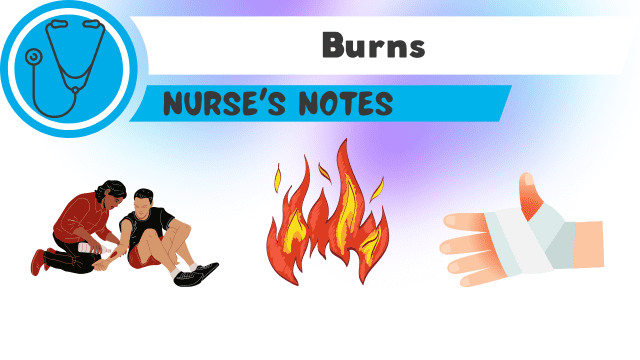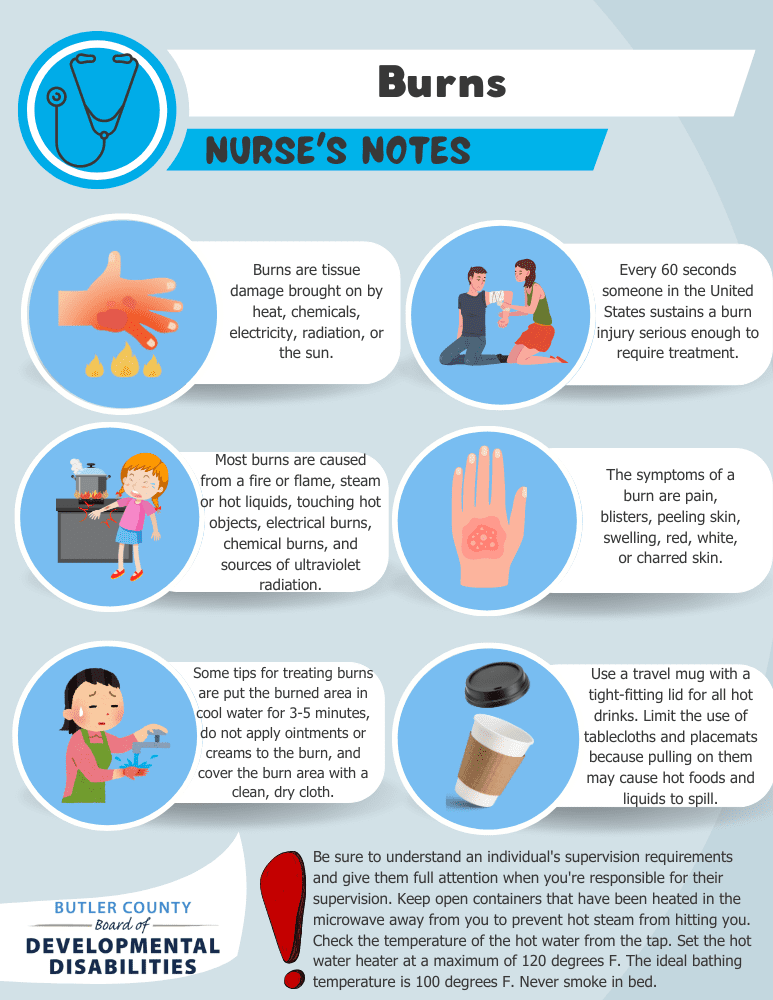
Nurse’s Notes: Burns
Every 3 months, our staff nurses share important health updates. This month, our nurses are talking about Burns.
Burns are tissue damage brought on by heat, chemicals, electricity, radiation, or the sun.
Did you know…
- Every 60 seconds someone in the United States sustains a burn injury serious enough to require treatment.
- 85-90% scald burns are related to cooking, serving, or drinking hot liquids.
- The majority of burns occur in the home. The most common burns in the home are scald injuries in the bathtub, shower, or hot liquid spills/splashes.
- The majority of burns are preventable.
What are the causes of burns from most to least common?
- A Fire or flame.
- Scalding from steam or hot liquids.
- Touching hot objects.
- Electrical burns.
- Chemical burns.
- Sources of ultraviolet radiation (sun, tanning beds, etc.).
The individuals that are at a higher risk for burns are those that have impaired motor or cognitive skills, depend on others for supervision and cannot self-rescue, have movement disorders such as, Tardive Dyskinesia, Parkinson’s, etc., have diabetes and peripheral neuropathy (decreased sensation in extremities), are on seizure medication levels lower than should be to avoid seizures, use oxygen, and those that abuse alcohol and drugs.
What are the symptoms of a burn?
- Pain
- Blisters
- Peeling skin
- Swelling
- Red, white, or charred skin
What are the 4 classifications of burns?
- First degree burn – the site is red, painful, dry, and has no blisters.
- Second degree burn – the site appears red, blistered, and may be swollen and painful.
- Third degree burn – the site appears white or charred, has no feeling since the nerve endings are destroyed, and may be painful around the burn.
- Fourth degree – the bones, tendons, and muscle are also burned.
Some of the possible complications after getting burn can be shock (decreased alertness, pale, clammy skin, and weakness), infection, dehydration from fluid loss, low body temperature, breathing problems, multi-organ issues, scarring, emotional, and psychological impacts.
What is the general first aid for burns and scalds?
- Remove all clothing, metals, and jewelry from burned area because they can retain heat and make the burn worse.
- Put the burned area in cool water for 3-5 minutes.
- Do not apply ointments, creams, or other home remedies to the burn. Do not apply ice.
- Cover the burn area with a clean, dry cloth.
- Most burns require immediate medical attention. If you have experienced a burn that requires urgent medical attention, please call 911 or go to the nearest emergency room.
- When calling 911 be sure to know your address and ensure your address is visible at your home.
Tips to preventing scalds and burns
- Use a travel mug with a tight-fitting lid for all hot drinks. Do not leave hot drinks unattended.
- Limit the use of tablecloths and placemats because pulling on them may cause hot foods and liquids to spill.
- Be sure to understand an individual’s supervision requirements and give them full attention when you’re responsible for their supervision.
- Keep open containers that have been heated in the microwave away from you to prevent hot steam from hitting you.
- Check the temperature of the hot water from the tap. Set the hot water heater at a maximum of 120 degrees F. The ideal bathing temperature is 100 degrees F. 3 seconds of exposure to a water temperature of 140 degrees is enough to cause a serious burn that requires surgery.
- Use a sunscreen with an SPF of 30 or higher and reapply every two hours or after swimming or sweating.
- Never smoke in bed.
- Stop using a vaping device if the battery is damaged. Use and charge your device properly to reduce risk of burns.
- When needed, use cool-water humidifiers or vaporizers rather than steam.
- Do not play with fireworks. The tip of a sparkler can burn up to 1800 degrees F.
- Keep a 3-foot safety zone around grills, firepits, and campfires.
- Use long handled tools for grilling.
- Don’t leave cooking food unattended.
- Turn pot handles away from the edge of the stove.
- Always use a dry mitt or potholder. Hot items can heat moisture in fabric and cause a scald burn.
- Keep the stovetop and oven clean, as a buildup of grease and debris can ignite easily.
- Wear short, close fitting, or tightly rolled sleeves when cooking.
- Install smoke detectors and test them monthly.
- Learn to use a fire extinguisher and always have one available.
- Have a fire escape route.

Sources:
https://pubmed.ncbi.nlm.nih.gov/8507362
https://www.templehealth.org/services/burn/how-to-prevent-burn-injury
